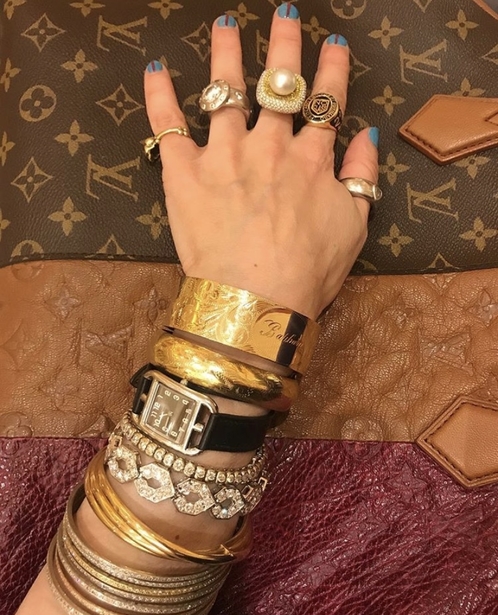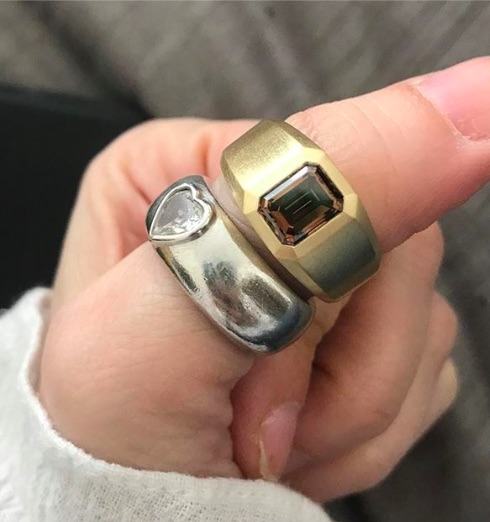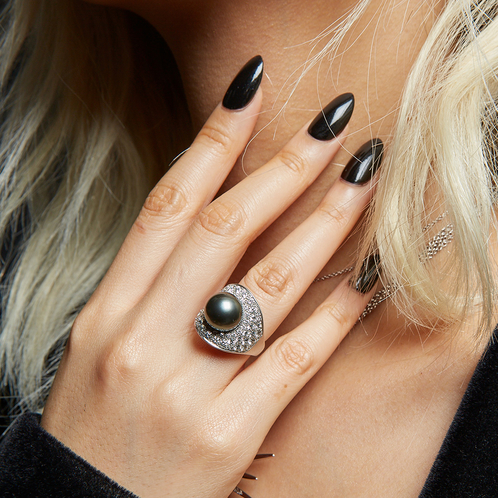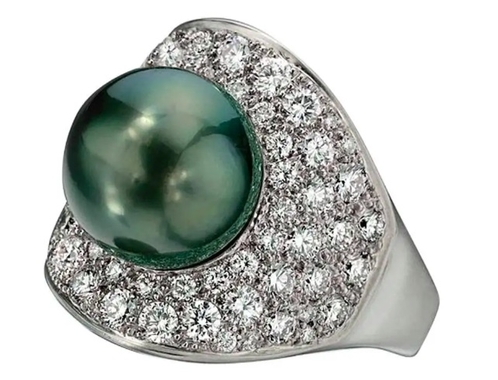In December, when actress Emma Stone showed off the pearl engagement ring given to her by writer/director Dave McCary, my first thought was, “I have to write that ‘Pearl engagement rings are bad‘ blog post AGAIN? Nah … I’m not gonna.” A few weeks later, actress Michelle Williams was spotted wearing what looked like a pearl ring from her director fiancé, Thomas Kail, and I was like, “I keep telling you to save pearls for cocktail rings. Y’all don’t listen. I’m not writing this again.”
But now that COVID-19 — the novel coronavirus — has descended upon the world, I’ve gotten a few general questions about wearing and caring for rings in the era of frequent, aggressive hand-washing. Therefore, I will give you my expert advice about gold and platinum rings based on my 15 years as a fine jewelry designer, before I get back to the specific question of pearls. Here’s my longtime, pre-COVID-19 advice:
Admittedly, in years past, I was more concerned about the welfare of your jewelry than your health. I’m not a doctor, so no one asks me to look at their sore throat, but plenty of people come to me with jewelry that’s been loved too much: necklaces with broken clasps, earrings with bent posts, and bangles that have been banged up. Mostly, they come to me with damaged rings, and most of those rings are engagement rings or wedding bands. Those are the rings that people wear every day. They wear those rings hard. But fine jewelry isn’t indestructible. Even diamonds — the hardest naturally occurring substance on earth — can be scratched, chipped, and broken clean in half. If diamonds were totally untouchable, we wouldn’t be able to cut them into sparkling facets and pleasing shapes.
I used to be amazed at the condition of some of the rings I’ve repaired because, as I wrote in 2008:
“I never would have expected people to wear beautiful fine jewelry while they drag their heavy suitcases through an airport, garden, shampoo a dog or work out. Not only do people do these things, but at the same time they’re hypersensitive to normal, unavoidable wear-and-tear on metal. Everyone wants to be able to wear their engagement ring to the beach yet never get a scratch on it.”
In contrast, I never wear rings at home. (Considering I find pants too confining to wear at home, jewelry is definitely unnecessary.) I put on rings to “go out” — meaning I’m dressing somewhat respectably (pants!) and anticipating I might interact with people. When I had a corporate job, the office was going out. Now, a meeting with a store is going out. Drinks with a friend is going out. A movie is going out. A fancy party is GOING OUT that calls for a fully bejeweled “I am a jewelry designer” look. This is my left hand/wrist when I’m GOING OUT.

Not shown: right-hand rings, necklaces, and earrings.
This is my left hand/wrist on days when I only leave the apartment to walk the dog, go to the gym, and run errands.

Petting Robin the Kitten also doesn’t require rings.
Even with all this care, my most frequently worn rings still get scratched up and dirty. I wear them while holding onto subway poles, opening cab doors, accepting change in a store, shaking hands, picking up a glass, leaning on a table. Imagine doing all that PLUS wearing those same rings while taking a shower, swimming in chlorinated water, chopping onions, lifting weights, cleaning the litter box, etc. Ew! Not only is the ring surface gross, but bacteria and viruses can live on your skin, under the ring you never take off, which is a major problem with COVID-19 on the rampage. Therefore, this is my updated ultra-responsible ring-care advice for the pandemic era.
- Be like me: Never wear your rings at home.
- Don’t even wear your rings out for the duration of the emergency.
- If you must wear rings out, choose quantity and style wisely. Few rings, and smooth surfaces.
I know it’s hard, because jewelry serves as psychological armor in addition to being beautiful to look at. But you’re not going to be able to wash a new and deadly virus off your hands thoroughly if a ring is in the way. Bonus: While you give your jewelry a rest, you can do some at-home cleaning. With streamlined gold and platinum all-metal or diamond-solitaire rings like these …

These are beautifully made but not intricate rings.
… an easy thing to do is soak the rings for at least five minutes in a bowl or cup containing warm water and a few drops of liquid dishwashing soap. A lot of jewelers recommend a gentle scrub with a soft toothbrush before rinsing. I think even a child’s toothbrush is too big and bristly for the ring’s outside surface, so I’d rather rub it with a microfiber cloth (damp on one end, dry on the other). Or, you can spend $10 on any liquid jewelry cleaner that comes with a strainer and a little brush. This video clip shows you what I mean by a strainer — you use it to lift the jewelry out of the solution easily.
I prefer buying the cleaning solution because having the little jar decreases the temptation to do this operation anywhere near the kitchen or bathroom sink. I put the solution on a table, put a small cup of warm water for rinsing next to it, have my cloth, and stay out of trouble. If you decide to get anywhere near a sink, close the drain AND put a towel in the sink. Take it from me and my customers: The reason we call accidents “accidents” is because they’re not planned! You can be sure you have a good grip on the ring. You can be sure the drain is closed. And still, the ring goes down the drain. Or you’re nowhere near the sink but you’re in the bathroom or kitchen, surrounded by tiled surfaces. You don’t realize how bouncy metal is until you’ve seen a ring ricochet off six different surfaces and fly down the drain in a way that would impress an NBA player. Nothing but net!
Fortunately, if that happens at home, you can take apart the pipe and rescue the ring from the drain’s trap (don’t let anyone use the sink before you do that). If you are not at home, you’re probably out of luck. That’s why I suggest leaving your rings home during this time. If you do wear rings and take them off to wash your hands, do not set them on the counter! Instead …
- Take the ring off and put it in a deep pocket or purse before entering the bathroom.
- Do whatever you have to do and wash your bare hands thoroughly with soap for at least 20 seconds.
- Dampen a paper towel with a touch of soap.
- Leave the bathroom.
- Sit down and take the ring out.
- Rub the ring with the damp towel and put it back on your finger.
- Clean the ring properly at home later.
Obviously the ring isn’t the cleanest it could be, but your hands were probably more of a problem, and now they’re clean. That said, this kind of cleaning isn’t good enough for someone who in a high-risk situation, like a medical professional, someone caring for a patient, an actual patient, etc. In those cases, again, just don’t wear rings for now. You can even take off your wedding band. Like I said in 2008 (though I’ve updated it to be gender neutral):
“Seriously, folks. Why do you wear your wedding jewelry to the gym and the pool? Do you think if you take it off, your marriage will be off too? It doesn’t work like that. If you’re so worried about your marriage, shower with your spouse, not with your rings.”
Now to the pearl problem! If you go up a few paragraphs, you’ll see that all of the pandemic ring-care instructions above are for streamlined gold and platinum DIAMOND rings. Diamonds aren’t indestructible, but they are hard as hell and hold up to more wear and tear than any other gem. It’s not all marketing hype: Diamonds are the most practical stone for an engagement ring, full stop. ALL OTHER GEMS ARE SOFTER THAN DIAMONDS. Sapphires and rubies are the next hardest stones, and I will custom-make engagement rings with those. But I won’t work with any other gems for engagement rings. Pearls and opals are, for me, completely out of the question. They’re soft and easily scratched. (Don’t “at” me if you’re that one person who has somehow kept a pearl ring in a pristine state despite everyday wear for 50 years. There’s always one exception. Congrats, you’re it.) I did a whole video about this in 2017.
The only way to clean a pearl or opal is to wipe the gem gently with a damp cloth with a little soap on it. Even I would rather bring a piece like my Luna ring to my jeweler for cleaning, which he’d do while looking at the piece through his microscope. I would never subject a pearl ring to random hand soap and coarse paper towels. I’d never soak it in cleaning solution either.
Turquoise and onyx aren’t as soft as pearls and opals but you can see that the extensive matte surface of this onyx skull cocktail ring isn’t suitable for rough wear.
Also, look at the intricate setting, the many tiny green garnets, and all the little crevices! This is the opposite of a streamlined design. Cleaning must be handled with care.
A few notes:
- Ultrasonic cleaners are okay for certain diamond solitaires, but the vibrations can dislodge the small stones in pavé settings and worsen fractures in delicate stones like emeralds. If you’ve got great-grandma’s diamond or you’ve been wearing your diamond nonstop for 30 years, there could be chips and cracks in the stone, or weakness in the prongs, that can lead to lost or damaged stones. Bring the old pieces to a professional jeweler for deep cleaning and repairs.
- For cleaning silver rings, you can use the cleaning solution and then attack the tarnish with a silver polishing cloth. I find that kind of relaxing, which is a good thing, because I’ve had to clean 100 silver stud earrings at once.
- Got brass costume jewelry? I don’t have any care expertise. Sorry!
Finally, if you love jewelry as much as I do and miss your rings, consider adding to your earring collection! No one has called for us to aggressively wash our earlobes … yet!
UPDATED TO ADD: Shout-out to fellow jewelry designer Sharon Zimmerman for suggesting you put important rings on a chain.
I put my rings on a chain after having this same conversation with other jewelry peeps. pic.twitter.com/Cj8bhcxCgt
— 🗽Sharon Zimmerman🗽 (@SharonZJewelry) March 16, 2020
This is a great idea if you have a few emotionally significant rings; one of my male customers has done it for years with his diamond engagement ring when he’s doing work outdoors. I won’t do this myself because which of my 10 frequently worn (and very heavy) rings would I choose? Besides, I’m used to being ringless much of the time. As long as I’m not forced to take out any of my 12 ear piercings, I’ve got my jewelry security blanket in place.



